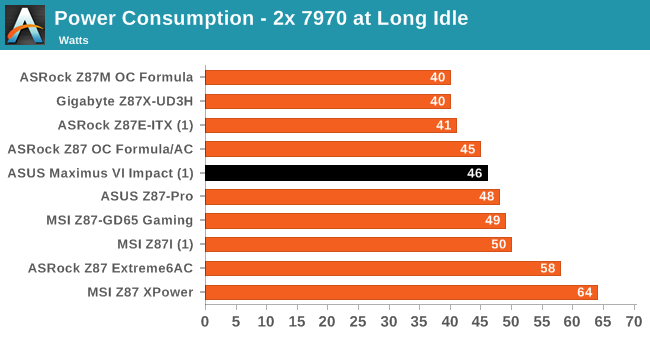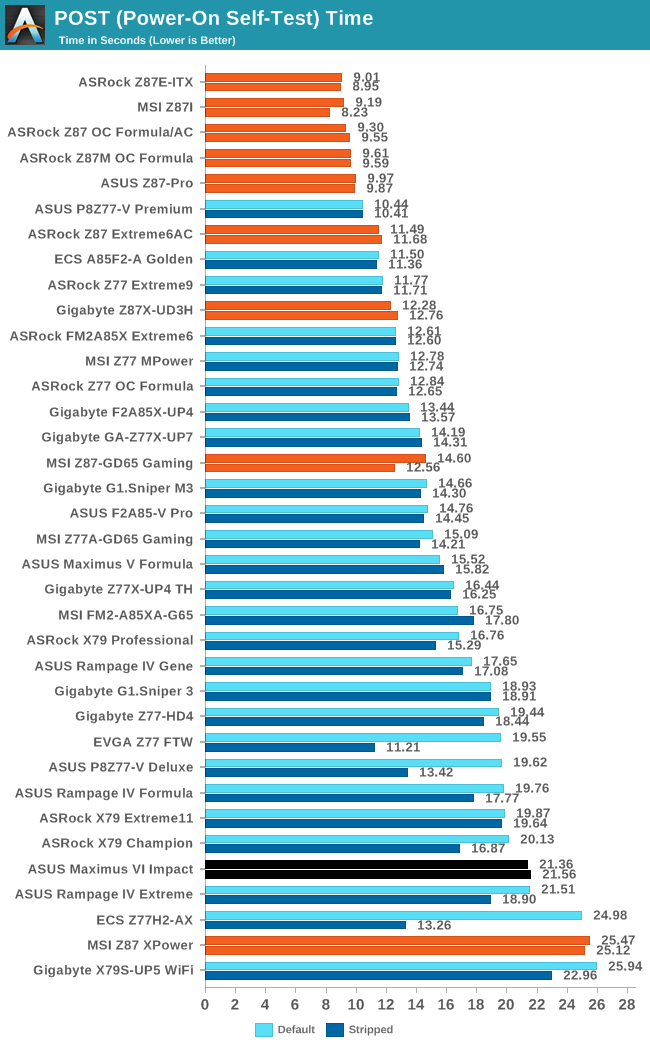ASUS Maximus VI Impact Review: ROG and Mini-ITX
by Ian Cutress on November 22, 2013 10:00 AM ESTMany thanks to...
We must thank the following companies for kindly providing hardware for our test bed:
Thank you to OCZ for providing us with 1250W Gold Power Supplies.
Thank you to G.Skill for providing us with memory kits.
Thank you to Corsair for providing us with an AX1200i PSU, Corsair H80i CLC and 16GB 2400C10 memory.
Thank you to ASUS for providing us with the AMD GPUs and some IO Testing kit.
Thank you to ECS for providing us with the NVIDIA GPUs.
Thank you to Rosewill for providing us with the 500W Platinum Power Supply for mITX testing, BlackHawk Ultra, and 1600W Hercules PSU for extreme dual CPU + quad GPU testing, and RK-9100 keyboards.
Thank you to ASRock for providing us with the 802.11ac wireless router for testing.
Test Setup
| Test Setup | |
| Processor |
Intel Core i7-4770K Retail 4 Cores, 8 Threads, 3.5 GHz (3.9 GHz Turbo) |
| Motherboards |
ASRock Z87 Extreme6/AC ASRock Z87 OC Formula/AC ASRock Z87M OC Formula ASRock Z87E-ITX ASUS Z87-Pro ASUS Maximus VI Impact Gigabyte Z87X-UD3H Gigabyte Z87X-OC MSI Z87-GD65 Gaming MSI Z87 XPower MSI Z87I |
| Cooling |
Corsair H80i Thermalright TRUE Copper |
| Power Supply |
OCZ 1250W Gold ZX Series Corsair AX1200i Platinum PSU |
| Memory |
GSkill TridentX 4x4 GB DDR3-2400 10-12-12 Kit Corsair Vengeance Pro 2x8 GB DDR3 2400 10-12-12 Kit |
| Memory Settings | XMP (2400 10-12-12) |
| Video Cards |
ASUS HD7970 3GB ECS GTX 580 1536MB |
| Video Drivers |
Catalyst 13.1 NVIDIA Drivers 310.90 WHQL |
| Hard Drive | OCZ Vertex 3 256GB |
| Optical Drive | LG GH22NS50 |
| Case | Open Test Bed |
| Operating System | Windows 7 64-bit |
| USB 2/3 Testing | OCZ Vertex 3 240GB with SATA->USB Adaptor |
| WiFi Testing | D-Link DIR-865L 802.11ac Dual Band Router |
Power Consumption
Power consumption was tested on the system as a whole with a wall meter connected to the OCZ 1250W power supply, while in a dual 7970 GPU configuration. This power supply is Gold rated, and as I am in the UK on a 230-240 V supply, leads to ~75% efficiency > 50W, and 90%+ efficiency at 250W, which is suitable for both idle and multi-GPU loading. This method of power reading allows us to compare the power management of the UEFI and the board to supply components with power under load, and includes typical PSU losses due to efficiency. These are the real world values that consumers may expect from a typical system (minus the monitor) using this motherboard.
While this method for power measurement may not be ideal, and you feel these numbers are not representative due to the high wattage power supply being used (we use the same PSU to remain consistent over a series of reviews, and the fact that some boards on our test bed get tested with three or four high powered GPUs), the important point to take away is the relationship between the numbers. These boards are all under the same conditions, and thus the differences between them should be easy to spot.

The M6I is middle of the pack when it comes to idle loading, whereas on game loading it competes with the other mini-ITX boards.
Windows 7 POST Time
Different motherboards have different POST sequences before an operating system is initialized. A lot of this is dependent on the board itself, and POST boot time is determined by the controllers on board (and the sequence of how those extras are organized). As part of our testing, we are now going to look at the POST Boot Time - this is the time from pressing the ON button on the computer to when Windows 7 starts loading. (We discount Windows loading as it is highly variable given Windows specific features.) These results are subject to human error, so please allow +/- 1 second in these results.

Normally our POST target is around 12 seconds, with under 10 being pretty good. The M6I comes in at over 21 seconds, which is a rather long POST sequence. ASUS’ Z87-Pro for example hit under 10 seconds, so I can only assume that this is more related to the add-in board detectors and boot sequence required.










69 Comments
View All Comments
coolhund - Saturday, December 7, 2013 - link
First things first. If you want quality youre at the wrong place with Asus anyway. Their mainboards die like flies.dcoca - Friday, January 9, 2015 - link
Who else would you pick? MSI (no thanks), Asrock ( lower tier Asus) , gigabyte ( I'll pass) ; I would agree on Asus video cards and their crappy coil whine issue.. but their motherboards are greatdcoca - Friday, January 9, 2015 - link
I think this board is great: it has the features that I need, it doesn't need to fit eveyone's bill.Morawka - Saturday, November 23, 2013 - link
Asus RAM Disk is awesome. Think Apple's Fusion Drive with 10X the performance.I always load whatever game i'm playing into the RAM DISK and keep it there until i beat the game or get bored with it. And then it goes back to the HDD for archive.
The best part is, RAM Disk will work on older boards, even x58 boards. I'm not sure if it's locked to Asus, but i was using it on my Rampage II Extreme about 4 months ago, and it worked like a charm.
Morawka - Saturday, November 23, 2013 - link
The only game i've not been able to fit on my RAM DISK is Battlefield 3 and 4. They simply are to big. I have 32GB of RAM.Gigaplex - Monday, November 25, 2013 - link
A RAM disk is not an exclusive feature of Asus. They've been around for decades.Rajinder Gill - Thursday, November 28, 2013 - link
You are correct, RAM disks have been around for ages. However, the functionality of the ASUS package is not available on any of the free offerings one finds on the web. The junction feature of the ASUS package is found on some of the commercially available packages which cost $30 to buy.Hairs_ - Saturday, November 23, 2013 - link
The market for Liquid-Nitrogen compatible >$200 Mini ITX boards is, I've heard, absolutely HUGE. Literally thousands of people waiting with baited breath on this review.Just as well the vast majority of people aren't interested in ~$100-$130 boards, because the lack of relevant reviews would really make them wonder whether tech sites are more interested in serving what the manufacturers' PR want than what buyers need.
ShieTar - Tuesday, November 26, 2013 - link
Oh, come on. AT review what they get. They don't have the budget to go and buy any damn Board they want to look at, and the low-margin board builders won't afford sending out hundreds of review samples. And for those products, AT is probably not the priority number 1. There are still lots of paper-magazines out there doing nothing but comparisons of "normal stuff", being read by people who want to have a quick help for their buying decision. These magazines are the best place to get your 80$-Mainboard reviewed in.aatroxed - Monday, November 25, 2013 - link
How would the onboard sound compare to a dedicated sound card? I'm still rocking an older creative xtreme music - would this more than match sound quality?